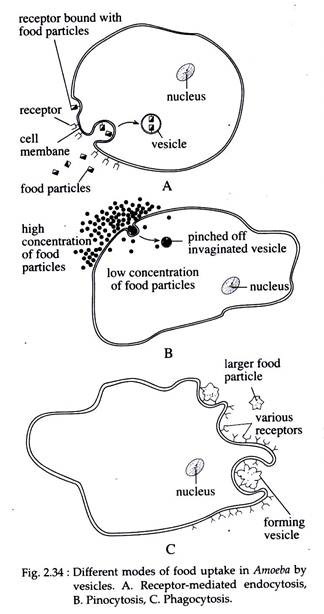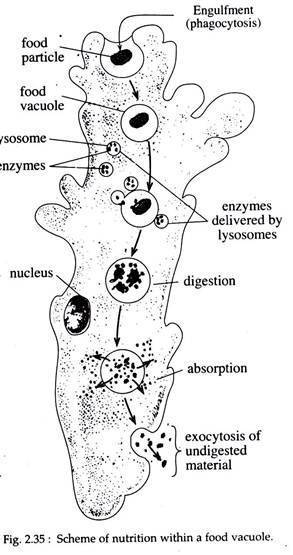In this article we will discuss about Feeding and Digestion in Invertebrates:- 1. Introduction to Feeding and Digestion in Invertebrates 2. Feeding in Invertebrates 3. Digestion 4. Some Examples of Different Types of Invertebrate Feeders 5. Pinocytosis 6. Phagocytosis 7. Process of Digestion.
Contents:
- Introduction to Feeding and Digestion in Invertebrates
- Feeding in Invertebrates
- Digestion in Invertebrates
- Some Examples of Different Types of Invertebrate Feeders
- Pinocytosis in Invertebrates
- Phagocytosis in Invertebrates
- Process of Digestion in Invertebrates
1. Introduction to Feeding and Digestion in Invertebrates:
The requirement of food by animals can be assigned on two major aspects:
ADVERTISEMENTS:
(i) To provide fuel in terms of energy so as to keep alive and maintain body processes, muscle contractions and so on, and
(ii) as raw materials for building and maintaining cellular and metabolic machinery, and also for growth and reproduction.
Generally, plants use the energy of sunlight and carbon-di-oxide from the atmosphere to synthesize all the components that constitutes it. All animals use chemical compounds to get energy as well as for their building materials. The chemical compounds or energy that animals need are derived from plants and therefore, indirectly from sunlight.
The acquisition and ingestion of food by the animals are referred to as feeding. The food taken by animals, whether of plant or animal origin, are composed of highly complex compounds. These compounds cannot be incorporated by the animals or used as fuels without being broken down into simpler units.
ADVERTISEMENTS:
The process of breakdown of complex food compounds into simpler one is known as digestion. A variety of chemical compounds can be utilized by the animals for energy. But for maintaining proper body function, animals require some compounds which they cannot synthesize-like vitamins, certain salts, some amino acids etc. The subject dealing with these supplies is called nutrition.
2. Feeding in Invertebrates:
There are various mechanical processes by which invertebrates capture food. The processes are developed in accordance to various kinds of food that a given animal can obtain and utilize.
Yonge (1928), grouped invertebrate feeding mechanisms into three major categories according to the size and type of food utilized:
ADVERTISEMENTS:
i. Microphagy:
These are mechanisms for dealing with small food particles. In this process pseudopodia, cilia, tentacles, mucus, setae and muscles are used for obtaining food.
ii. Macrophagy:
These are mechanisms for dealing with large food particles or masses. This process involves swallowing of inactive food, scraping, boring, and seizing the prey. After seizing the prey, the animals chew, swallow and may digest it externally.
iii. Fluid or Soft Tissue Feeding:
These type of feeders generally suck fluid food. Some pierce and then suck the body fluid of the prey and some simply absorb the liquid food from the substrate through body surface.
Morton (1967) adopted a classification in accordance with the nature of the food and considered five categories of animals:
a. Herbivores and Omnivores:
These animals have digestive system meant for plant and animal food digestion.
ADVERTISEMENTS:
b. Deposit Feeders:
These animals pass large amount of substratum through their gut.
c. Carnivores:
These animals depend upon animal proteins.
d. Filter Feeders:
They continuously strain small particles from large volumes of water, trapping the particles in mucus films or screens of setae and utilizing elaborate devices for sorting and transporting them.
e. Fluid Feeders:
They pierce and suck juices from animals and plants. There are several other animals which do not fit neatly into any of these classifications. They exploit whatever foods are available in their environment, viz., the brittle star Ophiocomina nigra is sometimes microphagous and sometimes macrophagous.
3. Digestion in Invertebrates:
The word ‘digestion’ comes from two Latin words meaning “to carry” (gerere) and “apart” or “asunder” (dis). In all the members of the animal kingdom, the food are made up of organic materials, e.g., carbohydrate, protein, fats, etc. These compounds have a very large molecular configuration.
The large molecules of food are first broken down into simpler units, like monosaccharide’s, amino acids, fatty acids and glycerol from polysaccharides, proteins and fats, respectively These are then absorbed and either incorporated into the body or metabolized to provide energy.
The process of digestion, thus involves the breaking of large and complex molecules of the food, after which, they become absorbable and available for use in the body. Digestion is an essential physiological activity in animals, whether they feed on minute food particles or on large plants and animals (exceptions, some internal body parasites and symbionts).
Digestive processes, particularly in macrophagous animals, are both mechanical and chemical. When large plant or animals are taken as food then mechanical digestion is essential. The final processes of digestion are always chemical, but there is frequently a pretreatment of the food, either before or after it is taken into the body.
i. Mechanical Digestion:
This is achieved with the help of the different components of the mouth parts and different specialised parts of the digestive tracts. In this process large mass of the prey are crushed into smaller parts mechanically.
ii. Chemical Digestion:
In this process smaller masses of prey are broken into simpler organic compounds with the help of different hydrolytic enzymes. The site of enzymatic action varies within the animal body.
According to the site of enzymatic action, chemical digestion is of two types:
(a) Intracellular Digestion:
Here digestion takes place within the cell. The protoplasm of the unicellular animal captures the food, encircles it in a food vacuole, digests it, discharges the wastes and incorporates the digested simple organic components into the protoplasm.
(b) Extracellular Digestion:
Here digestion takes place outside the cell and generally within the digestive tract of the higher animals. Digestion is wholly intracellular in Protozoa and Porifera. In other phyla extracellular digestion either supplements the intracellular mechanisms or completely replaces it. In the following discussion we shall describe the process of feeding and digestion in some invertebrates.
4. Some Examples of Different Types of Invertebrate Feeders:
Microphagy in Amoeba:
Amoeba is a member of Phylum-Sarcodina of Sub-kingdom-Protozoa. They are unicellular organisms and are present in marine, fresh water and terresterial habitats. They are entirely heterotrophic. Their food consists of all types of small organisms like bacteria, algae, diatoms, protozoans, and even small multicellular animals, such as rotifers, copepod larvae and nematodes.
Process of Feeding:
Amoeba as a non- ciliate and non-flagellate organism is wholly dependent on its membrane for food intake. The cell membrane acts according to the quality of the food to be consumed.
The actions of the membrane for feeding purpose can be described as follows:
(i) Permeation:
The semi-permeable cell membrane receives the small organic molecules, salts, ions and other molecules in two ways.
(a) Passive Diffusion:
In this process the soluble materials like sugars, amino acids etc. diffuse to the concentration gradient and move into the less concentrated protoplasm from the highly concentrated surrounding.
(b) Active Transport:
The protein channels of the cell membrane function as energy-requiring pumps, actively transporting certain molecules or moving ions in or out against their concentration gradient.
(ii) Endocytosis:
In this process extracellular materials enter the cell with the invagination of the cell membrane. The invaginated portion ultimately pinches off internally to form food vesicles. There are two basic types of endocytosis — specific and non-specific.
(a) Specific Endocytosis or Receptor Mediated Endocytosis (RME):
This process brings in proteins and other macromolecules at a faster rate than predicted by concentration gradient. These substances bind to the specific membrane receptors before they are taken into the vesicles (Fig. 2.34A).
(b) Non-specific Endocytosis:
Any types of dissolved or floating organic materials are taken in by this process. According to the nature of food this process is divided into two types – pinocytosis and phagocytosis.
5. Pinocytosis in Invertebrates:
Water, ions and small molecules of sugar and protein are absorbed by this process. In this process the cell membrane invaginates into the cytoplasm. The dissolved food with water enters into the invaginated portions. The rate of uptake is in simple proportion to the external concentration of the material being absorbed. The invaginated pit is then pinched off (Fig. 2.34B).
6. Phagocytosis in Invertebrates:
This is the process of engulfment of large particles, such as bacteria, protozoans etc. In this process multiple membrane receptors work synchronously to capture a large mass of food. Dynamic alteration of the cell membrane and cytoplasmic elements help to seize the prey (Fig. 2.34C).
7. Process of Digestion in Invertebrates:
In Amoeba, ingested food occupies a vesicle, called food vacuole, in the protoplasm (Fig. 2.35). The food vacuole initially contains both food and fluid. At the beginning, food vacuoles decrease in size due to diffusion of fluid outwards into the cytoplasm. At this stage, the acidity of the vacuole is nearly at a pH of 5.6. This acidity helps in the death of prey.
After that, the pH of the vacuole increases to about 7.3. This is due to the inflow of fluids from the lysosomes. Lysosomes come in contact with the food vacuole, fuse with it and release its contents within the food vacuole (Fig. 2.35). The lysosomal fluid contains hydrolytic enzymes. These enzymes perform the digestion of the killed prey (Fig. 2.35) until there remains only a small residue of un-digestible material.
The products of digestion diffuses from the vacuole into the cytoplasm of the cell where they may be used in metabolism by other organelles or stored after undergoing synthesis, into other forms, such as glycogen and lipid. The undigested material is discarded from the body by exocytosis (Fig. 2.35).

